Photographs: Rediff Archives N Madhav, Business Standard
The increasing number of vacant seats, inadequate faculty and bleak hiring is threatening the growth of leading technical institutes across the country. Here's a detailed look at the situation in states like Andhra Pradesh, Karnataka, Maharashtra, Gujarat, West Bengal and Kerala.
Andhra Pradesh: Policies, student migration take a toll
Andhra Pradesh, earlier synonymous with investments in the information technology (IT) and information technology-enabled services sector, is slowly losing ground to competition.
The industry here complains there is a dearth of quality engineering and management graduates.
As a result, many companies have postponed their expansion plans.
Most IT companies in the state are dependent on premier engineering colleges such as Indian Institutes of Technology, National Institutes of Technology, Indian Institutes of Information Technology and other central universities, besides the Jawaharlal Nehru Technological University (JNTU) and Osmania University.
"Pass-outs from premier universities and institutes are in good demand, as companies have to invest very little time and resources to put them on product development," said JNTU-Hyderabad registrar N V Ramana Rao. Companies were offering higher packages to attract these graduates, he added.
JNTU-Hyderabad has set up an entrepreneur development centre and a bureau of industry consultancy services.
It also has a centre for career advancement and resource development to help train students.
In 2012-13, the state saw 334,694 enrolments in various non-technical graduation courses, 78,560 in polytechnics and 500,780 in engineering, masters courses in computer applications and business administration and bachelors and diploma courses in pharmacy, according to the state government.
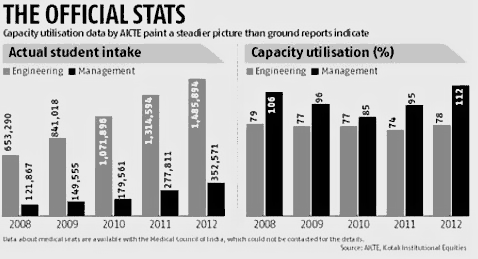
Bleak situation
A senior Indian Administrative Service (IAS) officer said the huge turnout was due to a populist scholarship scheme initiated by the state.
In Andhra Pradesh, a student securing a score of 25 to 30 per cent in the qualifying examination is eligible to seek admission in about 700 engineering colleges.
Underprivileged students get a full tuition fee reimbursement.
The state's annual spend on student fee reimbursements is Rs 3,800 crore.
The official said managements of private engineering institutes found it difficult to maintain industry standards in professional education, as the state regulated fees through its reimbursement policy.
"This has a direct bearing on employment opportunities. Financially, private colleges are ill-equipped to maintain high-technology laboratory facilities in their campuses," he added.
Through annual campus recruitments, companies were able to meet only 20 per cent of their hiring targets.
To bridge the gap, "they have been engaging private vendors for hiring services through the year", said Md Faisal, manager, SS Group, a vendor for business process outsourcing unit Genpact.
Despite this, companies fell short of targets by 60 to 70 per cent, he added.
Please click NEXT to continue reading...
Andhra Pradesh: About 15 private colleges applied for closure every year in the last three years
Image: For representational purposes onlyPhotographs: Sahil Salvi/Rediff.com
Vacant seats
In the past three years, many private engineering colleges in the state have shut, owing to low student turnouts.
This year, about 1,50,000 engineering seats would go vacant -- only 2,00,000 passed the engineering entrance examination, against the capacity of about 3,50,000.
On an average, about 15 private colleges applied for closure every year in the last three years, according to the All India Council of Technical Education.
N L N Reddy, placements officer at city-based CBIT College, had earlier told Business Standard as many as 110 colleges with masters programmes in business administration and computer applications, applied for closure this year.
He added colleges in districts close to Hyderabad might record only 50 to 100 admissions.
Despite having about 710 colleges, the state has been witnessing huge student migration due to prolonged agitation over the state's bifurcation.
According to some sources in private colleges, students from the state were now looking at states such as Tamil Nadu, Karnataka, Maharashtra and Rajasthan, as well as other countries such as the US, Germany and Australia.
Sources in the Andhra Pradesh State Higher Education Council, the nodal agency for engineering admissions, said due to delay in admissions and the falling standards in the sector, about 250 colleges had reported less than 100 admissions each last year.
Please refer to the graphical image below to understand the gravity of the situation:
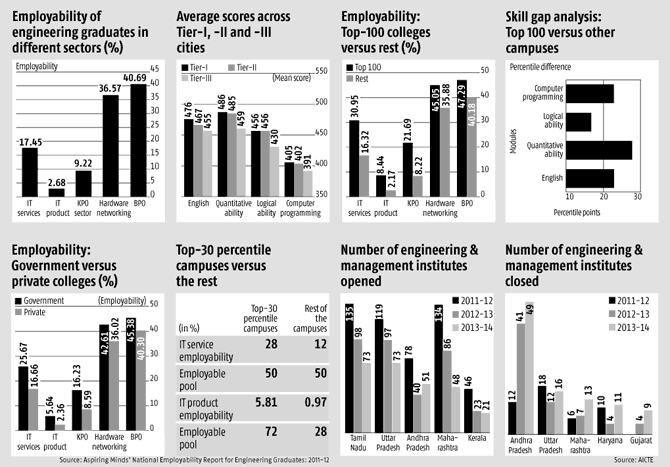
Improving employability
For technical as well as general education, policies should be aimed at role-based training in the last two semesters, said T Muralidharan, chairman of market researcher TMI Group.
He added companies could no longer afford to spend valuable business hours in training freshers -- the onus was on institutions.
Speaking on the scholarship policy here, he said, "Many unwilling students prefer to join engineering to simply make use of the policy. Instead, it would be better if the state limited its intervention through a 50 per cent reimbursement."
The Rajiv Education and Employment Mission in Andhra Pradesh proposes to employ about 1.5 million youth in the private industry by next year.
Under this scheme, candidates are trained to acquire job skills, in close coordination with the industry.
West Bengal: Premier schools suffer, too
Image: For representational purposes onlyPhotographs: Rediff Archives Digbijay Mishra
Two of Bengal's best-known engineering campuses, Bengal Engineering and Science University or Besu and Jadavpur have 100 vacant seats between them.
The full picture is more alarming.
If technology colleges (engineering colleges) across the state are considered, the number of empty seats is 16,000, around 45 per cent of the 35,000 seats offered.
This clearly shows that students have placement, infrastructure and quality on their mind.
To make matters worse for technical education institutions here, major information technology (IT) companies are only opting for need-based hiring.
The reasons for empty classrooms are many.
First, too many private engineering colleges have come up.
In 2012-13, over 7,000 seats went empty across private colleges in the state, but another 2,000 seats were added via new engineering colleges and permission to increase students in certain colleges.
Some students are opting for regular graduation courses, as it offers greater value in a sluggish job market compared to an engineering degree from a low-rung private college.
The second outcome is that some are leaving the state to join other national-level colleges that have a strong reputation on the quality of education.
Bhaskar Gupta, chairman of the West Bengal Joint Entrance Examination, responsible for testing students for engineering colleges, said this scenario has been building up.
"There is a demand-supply gap. So many students are passing out (graduating), but so few jobs are on offer," he said, adding the gloomy trend for engineering colleges in the state is likely to continue next year.
New colleges often have inadequate faculty. "You need credible faculty based on which industry would take note of you. Companies won't recruit someone with sub-standard knowledge and skills," Gupta added. Many of the IT companies are also opting for off-campus recruitments.
Vinod Juneja, managing director of Binani Cement, said the quality of private colleges was questionable. "These seats are paid. If one has the money, one can get enrolled. So, many times the skills of youngsters coming out of these colleges are not up to the mark," he said.
Karnataka: Thick canopy of colleges; sunshine only at top
Image: For representational purposes onlyPhotographs: Rediff Archives Praveen Bose
A churn in the professional educational sector in Karnataka has meant it is now a case of survival of the fittest.
Earlier, the opening of the sector led to many sniffing an opportunity. Colleges and courses were launched regularly. With no checks on quality and a dearth of good faculty, little heed was paid to the industry's needs and demands.
Now, it's a problem of plenty. "In Karnataka, there are at least five colleges that have less than 100 students, and these may shut," H Mahadevappa, vice-chancellor, Visvesvaraya Technological University, told Business Standard.
Before 2000, colleges were lucrative, with people paying Rs 10 lakh or more for admissions. Now, 10 to 20 "well-reputed and good colleges" were faring well, while many management institutions were in a dismal situation, Mahadevappa added.
The state's 200 colleges offering engineering courses account for 83,489 seats.
During academic year 2013-14, 18,861 seats, or 22.6 per cent of total seats, remained vacant. In the case of medical courses, five to 10 per cent of the seats were vacant.
Through the last three years, every student who applied for a professional course secured admission to the course of his/her choice. With such oversupply of seats, the filtering mechanism was diluted and, therefore, quality was hit.
"You just need to pass the entrance exam and you are sure to get a seat somewhere or the other," said a senior industry official.
Add to this the new pay scale mandated by the All India Council for technical Education -- a professor would get Rs 1 lakh a month, an associate professor Rs 75,000, and an assistant professor Rs 45,000. So, unless all seats are filled, colleges cannot afford to pay their faculty, let alone ensuring quality.
The oversupply of students, however, hasn't meant an increase in the number of those who are industry-ready.
Sangeeta Lala, co-founder and vice-president, TeamLease Services, says, "Only the top institutions are able to cater to the industry demand for quality human resources. The products of second-rung and other institutions are unemployable. There's a mismatch between what industry needs and what is produced by these institutions and, therefore, it's only the cream from the top institutions that is employable."
A senior official of city-based privately-held Alliance University said, "A significant number of those coming out with professional degrees do not have the right skills. If there's no quality, there's lack of demand." This was more so in the case of graduates from institutions that lacked proper industry interface, she added.
Even as many are seeing a fall in the demand for their courses, some claim to be bucking the trend because of the quality of education and the subsequent market opportunities.
"Though there's mushrooming of colleges in the city and elsewhere, unless there's quality, you don't go to a college," said Ranjan Pai of the Pai family, which runs Manipal University, adding, "Better schools are getting a larger share of the applications."
Pai said applications for admissions to engineering and MBA courses in Manipal University had seen a rise.
Some institutions claim to provide training in disciplines that meet industry needs.
Bangalore's Christ University has been introducing courses in tune with changing industry needs.
"We have courses that are more in tune with the demands of today's world," said a Christ University spokesman.
Maharashtra: Risk-averse students punish colleges
Image: For representational purposes onlyPhotographs: Ahmad Masood/Reuters Kalpana Pathak
Nandu Sharda, 24, sat for the Common Management Admission Test twice this year but failed to get admission at Mumbai's Jamnalal Bajaj Institute of Management Studies.
Other institutes in Mumbai suburbs offered her admission, which she declined as she did not want to spend money on nondescript institutes.
She is not alone. Most students are giving such institutes, which have failed to provide placements in these difficult times, a miss.
This is one reason why 40 per cent or 53,264 seats of the 1,35,000 engineering seats in Maharashtra have gone vacant this year.
In management courses, two-thirds or 24,213 of 36,447 seats are vacant. According to officials from the Directorate of Technical Education (DTE), Maharashtra, most vacancies are in Pune, followed by Nagpur and Mumbai.
A 15-member DTE committee headed by joint director Dayanand Meshram said students want to study only at popular colleges in Mumbai, Pune, Nashik, Aurangabad, Amravati and Nagpur, as these colleges guarantee jobs.
The other contributing factor to empty classrooms, despite a growth in the number of seats and relaxed eligibility criteria for admission, is the lack of quality faculty and poor infrastructure. However, none has deterred institutes from charging hefty fees.
In Mumbai, reputed institutes such as Veermata Jijabai Technological Institute had 27 vacant seats, Sardar Patel Institute of Technology, 19, and K J Somaiya College of Engineering, 15.
The DTE officials say seats are going vacant especially in programmes such as information technology (IT), civil engineering and electrical engineering.
Students also seem to prefer courses in computer science, mechanical engineering, and electronics and telecommunication engineering, which have better placement prospects.
To combat the problem of vacant seats in management schools, 35 schools have converted minority quota seats into general category.
Down by half
For the first time in three years, the number of new management and engineering and technology institutes being opened in the country has come down by half.
In FY12, 892 management and engineering and technology institutes were opened in India and 626 institutions in FY13. In the current financial year, 494 management and engineering and technology institutes have sought AICTE's permission to set shop.
Among the states that lead in setting up institutions are Tamil Nadu and Uttar Pradesh, followed by Andhra Pradesh, Maharashtra and Kerala.
While Tamil Nadu and Uttar Pradesh have seen 73 each management and engineering and technology institutions in FY14, Andhra Pradesh has seen 51 institutes and Maharashtra 48, respectively. Kerala has seen 21 new institutes being set up.
"We have thousands of B-schools, but hardly a few are on the Top-500 list at the global level," says Harivansh Chaturvedi, director, Birla Institute of Management Technology, Noida.
Shankar S Mantha, chairman of AICTE, says: "If an entrepreneur says I am willing to put in money and get the resources, including making land available, as a regulator I cannot stop him. As for quality, it’s up to the institutes."
Tamil Nadu: Too many colleges, too little quality
Image: For representational purposes onlyPhotographs: Courtesy Careers360 Gireesh Babu
In Tamil Nadu, nearly 40 per cent of the total number of 250,000 engineering seats -- government and private colleges put together -- failed to find takers this year.
Industry players say although Tamil Nadu saw it coming, it did little to stem the indiscriminate increase in the number of seats.
Between 2009 and 2013, the number of seats has jumped from 78,664 to 124,774, a 60 per cent jump. However, the number of seats vacant during the period has swelled 160 per cent, from 31,165 to 80,689.
In eight years, Tamil Nadu has seen the number of private engineering colleges more than double, from 224 to 542.
The All India Council for Technical Education (AICTE), the country's technical education regulator, may not be worried about giving the green signal to new colleges despite engineering and management seats going vacant, but the industry is.
Aditya Narayan Mishra, president (staffing) and director (marketing) at Randstad India, says some of the institutions have increased the number of seats with an eye on the number of youth in the country.
"There was an increase in the seats and number of colleges, while the demand did not match with the supply. There was a positive sentiment during the 2000-2007 period, which resulted in institutions over-estimating the upcoming demand for facilities and seats."
A K Natesan, secretary of the Association of Management of Coimbatore Anna University Affiliated Colleges, agrees. "While the number of students joining was a little more this year than last year, the higher number of seats available has resulted in several seats remaining vacant.” The association blames the AICTE and says it has given representation to limit the number of seats.
Many institutions don't have quality faculty, relevant infrastructure or well-equipped laboratories. The proliferation of institutes and students-not-ready-for the job market have impacted placements.
A study by Aspiring Minds, an employability solutions company, notes that of 3,000-plus engineering campuses in the country, the top-tier or the best of colleges have employability as high as 50 per cent, whereas the bottom 30 percentile colleges have employability of less than 10 per cent.
Only 35 per cent colleges have employability more than the average figure of 17 per cent, whereas the majority (65 per cent colleges) have it close to or lower than 17 per cent.
This clearly shows there are a small number of colleges with very high employability, followed by a high number of colleges with very low employability.
According to G Viswanathan, founder and chancellor of VIT University, Vellore, the problem with engineering institutions is their unequal distribution. "Most institutions are concentrated in Tamil Nadu, Andhra Pradesh and Maharashtra. There is a disparity in distribution of institutions, as Andhra Pradesh has around 700 institutions, while Bihar has only around 10. One way to solve the issue is to attract more students from states which have lesser institutions to the states which have more institutions."
AICTE says it cannot be solely blamed. If institutions seek additional seats and meet all the criteria for expansion, the regulator would approve these. Technical institutions have to give an online application for increasing their seat capacity and "only if they apply, will the seats be allowed". AICTE would approve if the college is eligible, based on the deficiency report.
Medical seats
If there is a problem of plenty in engineering and technology seats, the situation is the opposite when it comes to medical seats.
While demand for medical seats is 20,000-25,000, the availability is 3,000.
At the national level, the demand is of 500,000 against the availability of 45,000, says Viswanathan. Humanities and science in Tamil Nadu do not see a major demand-supply crisis. "Almost 100 per cent of the seats are filled in these courses," says Karu Nagarajan, member-secretary, Tamil Nadu State Council for Higher Education.
Gujarat: Lack of linkages with industries and institutes affecting employability
Image: For representational purposes onlyPhotographs: Jayanta Shaw/Reuters Vinay Umarji
In 2011-12, there were 138 management institutes in Gujarat.
The number came down to 132 in 2012-13. Government officials and academicians say this is a correction that had to happen for quality institutes to emerge.
Higher education in Gujarat, be it technical or non-technical, has been growing in five-10 years, though at a pace slower than of Karnataka, Tamil Nadu, Andhra Pradesh and Kerala.
What has worked in Gujarat's favour is its late entry in higher education. Lack of large information technology (IT) firms and recent industrialisation meant the need for higher education institutes was not felt for a long time.
"In five-10 years, there has been a sudden spurt in the number of higher education institutes, though it happened later in Gujarat than other states. Most new institutes were looking for short-term gains," says B H Jajoo, former dean of Indian Institute of Management, Ahmedabad (IIM-A).
"When we talk of infrastructure in higher education, it does not mean physical. The infrastructure in terms of quality faculty, curriculum, overseeing regulatory framework and quality of students is yet to develop well."
Minister of state for education, Vasuben Trivedi, said since 2010, 36 private colleges offering engineering, management and pharmacy education had closed. There is no clear data on the total number of colleges.
15 per cent vacant seats
In 2012-13, 8,500 seats or 15 per cent of 55,700 seats in 118 engineering colleges, including government and private ones, remained vacant.
Of the 25,000 management seats under the Gujarat Technical University (GTU), two-thirds remain vacant, says Ritesh Hada, managing director of UnitedWorld of Business School. GTU is a state-wide institution affiliating many esteemed engineering, pharmacy, and management colleges and varsities.
"Correction has also happened. Even the number of dental colleges have come down. This is also because that many of the institutes opened up in rural areas as well as urban areas, and only the ones in urban areas are doing well. Institutes in rural areas have not been able to attract students, since all the jobs are being created in urban areas," says Hada.
Jajoo says the vacancy of seats is good for higher education.
"In education, gestation is a bit longer and in a way, vacancies are good, since they help filter out institutes that are not of quality," he reasons.
State government officials say there is a definite need of regulation in setting up new higher education institutes. "Not everybody should be allowed to set up an institute. Rather, a thorough background check should be done. Some regulation needs to be made," says Chandan Chatterjee, director of the Centre for Entrepreneurship Development, Government of Gujarat.
The mushrooming of institutes has also impacted employability of graduates. Chatterjee states only 15 per cent of graduates are employable in Gujarat. One reason is lack of active linkages between institutes and industries, he states. "As far as unemployability is concerned, demand and supply is not an issue. It is the linkages that are not happening," he adds.
According to Madhu Mehta, techno-entrepreneur and mentor for several incubation centres in the state, a number of colleges in Gujarat do not run at full capacity. "More, their placement records are mixed. This impacts employability," says Mehta.
Student mindset
In Gujarat, students' mindset has also been a challenge in enhancing their employability. "Students only want to go for conventional industries. Though Gujarat is known for its textile and gems and jewellery, they are of least priority for professionals, who instead want to join Tata Motors or other large industries. Certain industries and professions need to be popularised by the state government," says Chatterjee.
The other problem among students as far as unemployability is concerned is lack of conceptual understanding. "Knowledge of how the world, economy or society works is lacking. The intellect isn't developed and graduate education is taking a hit. The other aspect of unemployability is lack of technical know-how," says Jajoo.

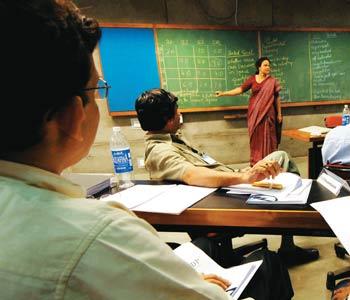

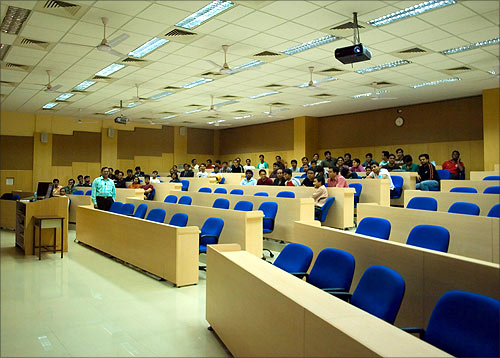
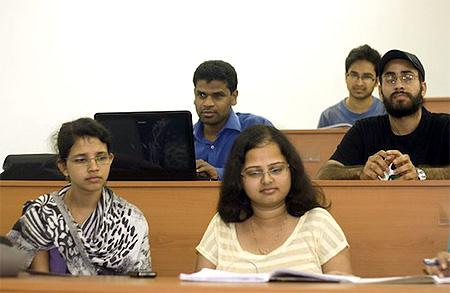
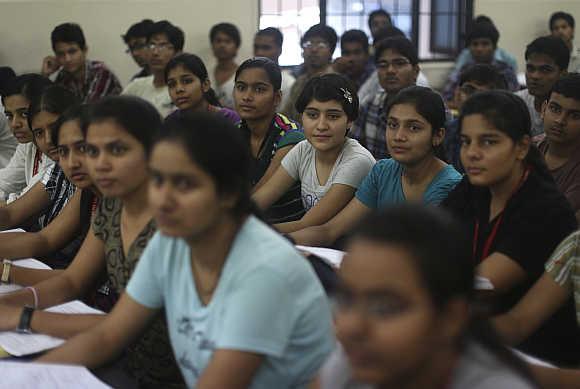
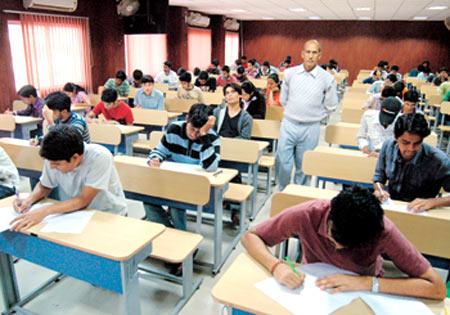
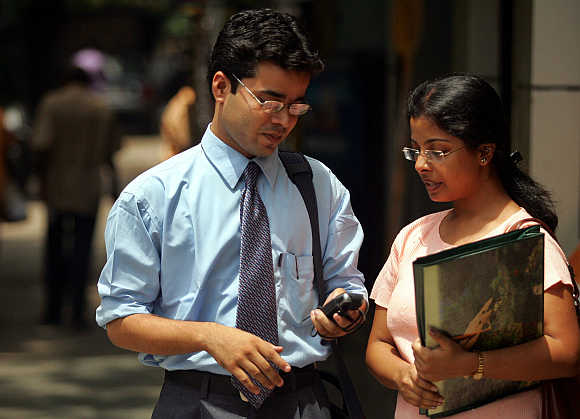

Comment
article